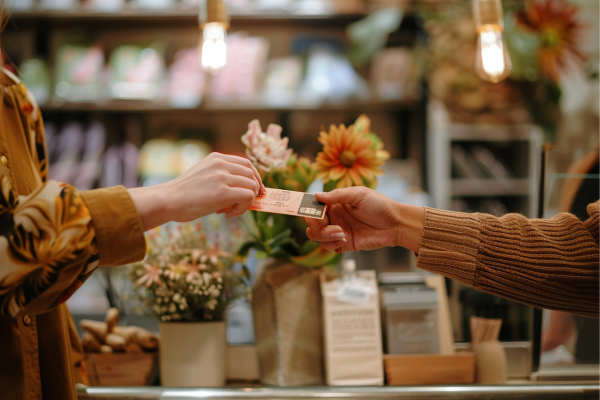These days, the desire to build authentic business relationships is no longer considered an endearing characteristic of a company, now it’s a necessity in getting an edge on the competition. Modern brands are working hard to respond to current consumer demands, who want to feel valued by the brands they buy from.
But building trust from consumers and developing a community of genuinely connected customers requires a solid strategy of communication.
“Companies that provide an emotional connection with customers outperform the sales growth of their competitors by 85%” (Gallop)
The focus has shifted. It’s no longer enough to simply offer customers the products they want, or need, now it’s about connection. Consumers want to feel they are a part of a community, and it has to mean something to them. Getting that formula right can be the catalyst to a business striding miles ahead of their competitors.
Meet Jenn Donovan. Jenn is a successful author and podcaster, as well as an experienced keynote speaker. With over 15 years industry experience, Jenn really knows how to use marketing as an effective tool to help a business to grow.
Jenn fully understands the importance of building a strong community that aligns with a brand’s values. In this Q&A, she reveals her secrets to what drives a community to gain momentum organically, using marketing strategies effectively to make sincere connections with consumers – and keep them coming back.
Welcome Jenn!

Why is an authentic community so vital to the success of brand?
People want to feel like they belong to something. We do business with people who we feel appreciate us. So, if customers feel that a business doesn’t really care whether they spend their money with them or with a competitor it really weakens their relationship. As a business owner, you need to ask yourself, “What are you doing to make that person feel like they matter to your business?” It could be as simple as knowing their name. It’s about trying to create a connection.
A lot of larger businesses use loyalty programs, which is great for data collection, but they also use it to connect with their customers, by personalising that data and connect with them through their marketing. It’s a very tailored process, but effective, making someone feel like they ‘belong’ to a brand’s community, and that the business really cares about them.

Quality over quantity
If you are still looking at your marketing in the form of numbers, panicking over thoughts like, “I need more followers on Instagram. I need more subscribers on my email list. I need more people to like my Facebook page.” Without sounding really harsh, if you’re looking at those as a metrics of measure of success, you’re kind of doing it wrong.
You need to be thinking about your customers as more of an active community, rather than ‘followers’. Followers, in the same way as an audience, are an entity you would potentially talk ‘at’. But customer connection is all about two-way conversation.
As a business owner, you are the leader of your community, but the community is also talking to each other. Your role is to create opportunities where individuals can talk to other people in the community. That’s the real essence of a community.
I think a lot of our social media, and our marketing strategies, these days tend to be focused on that one-way conversation. For example, I put up a post, and you read that post and you might comment on that post, or I send an email and you read that email. But you’ve got to work out how you can get the conversation coming back to you.
“77% of consumers view brands more favourably if they seek out and apply customer feedback” (Forbes)
In your social media captions, are you asking for people to offer their opinion? You should be actively asking them to ‘like’ the post or to ‘comment below’. Social media is meant to be ‘social’ the hint is in the name! It’s not ‘post and see who reads it’ media – it’s social media. You’ve got to get out there and be social!

Nurture by nature
A lot of people concentrate on the ‘cold traffic’ – sourcing new customers and introducing them to their brand. A lot of focus is put on marketing to those people, but what about the ‘warm’ people, who know who you are but are currently ‘sitting on the fence’, or the ‘hot’ people who’ve actually bought from you before? What are you doing to nurture them to come back again?
Some of your marketing needs to be focused on the people who’ve already bought from you, getting them back in, getting them to be that all-important ‘super fan’. These are the customers who’ll tell others about your business in ways that traditional marketing won’t reach as effectively.
Introduce loyalty programs and reach out to those customers. Send them a personalised email or spotlight them in one of your social posts. Make them feel special and give them a reason to genuinely feel that you care about them. If you can get every customer who bought from you in 2025 to come back twice more in 2026, your business is going to grow exponentially simply by retaining those customers.

Surprise and delight
I love this concept. A lot of marketing is based on addressing pain points – it’s focused on fixing something that ‘hurts’, to make consumers take action and buy a product to help with that issue. But many consumers don’t react to marketing through pain points. So here’s how to flip the switch – ‘surprise and delight’ them.
Send loyal customers a freebie product for them to try. For example, if you have a business in food and hospitality, maybe offer them a sample of your new poppy seed dressing. That customer will feel special that you’ve chosen them to try it. They may use it for their guests, who might say “Whoa, where did you get this from? This is delicious!”
So now your marketing has become focused on offering customers a feeling of pride – they’re thinking, “Great, I’ve got something everyone else wants.” Don’t underestimate how powerful this strategy can be. Yes, addressing pain points can be effective, but surprising and delighting your customers revolves around positivity and an enjoyable experience. What would you rather offer your community?

The ‘7-11-4 Rule’
This is sort of the golden rule in marketing; it’s basically talking about the number of steps needed to attract a new ‘cold’ customer. It translates as follows: 7 hours of content, 11 different touch points (in other words, 11 different ways of hearing from you), and 4 different mediums (billboards or emails) or different platforms (such as Instagram, Facebook, LinkedIn, your company website).
So, imagine as a consumer you’ve gone onto a website, and you’ve seen some beautiful flowers that you might like to send mum for Mother’s Day. All of a sudden you’re on Facebook and that ad keeps popping up or you go to LinkedIn and here’s this ad again. That’s ‘top of mind marketing’ working for you. It’s trying to track you, trying to keep top of mind. And that’s what ‘The 7-11-4 Rule’ is trying to do – keep showing up in different places to catch your attention and keep your product or service top of mind.
It sounds like a lot, but it’s a slow burn, not simply rushing out 7 hours of content in a month! More like spreading your content net wide and doing it regularly across the year, talking about your brand and your products and starting conversation, so that consumers can you get to know you, trust you, and ultimately buy from you.
This isn’t a rule with numbers set in stone, it’s a practical guide that on the whole works effectively. If you’re finding your marketing strategy isn’t getting the traction you’d hoped for, then ask yourself: “Do I have 7 hours of content out there? Have I used 11 different touch points, and am I showing up in 4 different areas?”

Avoid focusing on vanity metrics
This goes back to the idea of not getting lost down a rabbit hole of chasing ‘followers’ without having any real engagement with them. If you’re looking at your competitors thinking “Gosh, they’ve got 3,000 followers and I’ve only got 500,” you’ve got to question how many of those 3,000 are genuinely engaged? How many of those followers are actually buying their products?
You might only have 500 followers, but if 460 buy from you every time you put up a post, just imagine how much more profitable that is over a business with thousands of community members who are mostly inactive. Trying to compete with your competitors on the basis follower numbers is just vanity.
Absolutely do keep track of your numbers, but focus on the ‘real’ numbers. Study your analytics data and accurately measure your social media insights against your sales records. Build your community authentically; use brand ambassadors genuinely aligned with your values, and collaborate with people who speak directly to your community, starting genuine conversations.
It’s still one of those big things that people come to me and say, “Jenn, I just need more followers.” And I reply, “No, you don’t. You just need more paying clients. So, let’s look after the people that are following you.” You’d be surprised at how quickly ‘FOMO’ kicks in, and more people get interested. It’s because they can see the amazing job your business is doing, and they want to join in on that community and get involved.
Good luck!
Jenn has many more tips to share, and you can catch up with her latest blogs and podcasts on her website.

